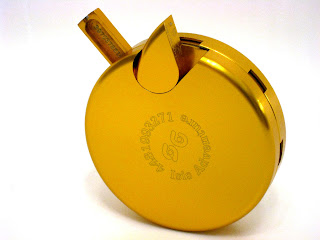Since my review of the Cross Threaded earlier in this blog, I subsequently developed quite a liking for nut and bolt puzzles and acquired four others:-
1. 2 x Bolted
2. Schraube
3. One-Wa-Sure
 |
| Top from left: Eureka Bolted, Enigma Bolted, Schraube and at the bottom, One-Wa-Sure |
I ordered a copy from Mr Puzzle Australia and for some reason which I still cannot fathom, I ordered an almost identical one from PuzzleThis UK. Anyhow, the one from Mr Puzzle Australia is manufactured by Enigma while that from PuzzleThis UK comes from Eureka. Both are relatively large in size measuring 9.3cm x 3cm at its widest. Quality and construction for both copies are good. The one from Enigma is made of brass with a nice patina finish while the other from Eureka I think is made of aluminium with a shiny surface.
If you wish to buy one, get the Enigma one as it has got a nicer finish and looks like a real bolt. They are really more trick bolts than puzzles and I solved them (removing the bent washer) in under 15 seconds. In my opinion really not worth the money if you are looking for some puzzling.
Schraube
This one came from Hendrik Haak's Puzzle-Shop.de. Schraube is german for screw. Made of aluminium, the quality and finish is also good and with a matt surface, it too looks like a real nut and bolt. This is the smallest of the lot at around 4cm x 1.9cm. From a puzzling standpoint, this one is a bit harder than the Bolted and required more manipulation before I could get the nut off the bolt. The mechanism is similar to the Cross Threaded mentioned earlier.
One-Wa-Sure
This bolt puzzle with a catchy name (play on the word washer) came from Rocky Chiaro. In terms of size, it is somewhere midway between the Bolted and Schraube. Measuring about 6.3cm x 2.2cm, it is made of brass with a nice polished surface. Quality, fit and finish is excellent as is typical of Rocky's brass puzzles and the head of the bolt bears Rocky's signature. However, all this quality and craftsmanship comes at a price; the One-Wa-Sure is not cheap! It is one of six bolt and nut puzzles designed and made by Rocky; so if you are thinking of collecting the lot, this will definitely burn a pretty large hole in your pocket.
This is the hardest to solve compared to the other two and given the cost, I am glad the One-Wa-Sure provides reasonable challenge. It didn't take me that long but I still had to play with it for a fair several minutes before I managed to remove the washer from the bolt. I cannot comment on the difficulty of this one compared to the rest of the series as I don't have the other five, so you may want to check out Oli's review that covers all six puzzles. It was on his recommendation that I chose the One-Wa-Sure over the rest as I wasn't ready to plonk down money for all six puzzles at one go without at least trying one.
Out of the four above, only the One-Wa-Sure is really worth buying, that is, from both a puzzling and quality standpoint. But if you are a collector, well, that's a different story...no harm getting all four I guess.




